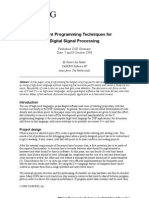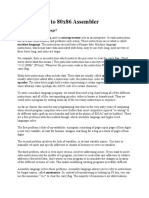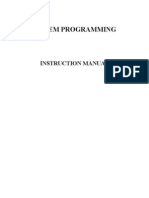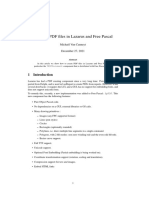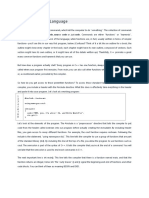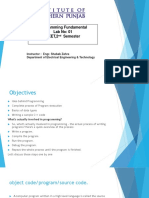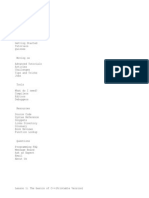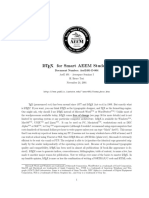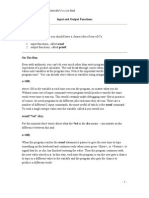2.3 Drawing Operations: Need To See If It Really Works For All Tasks, and If Not Then Get Rid of It
2.3 Drawing Operations: Need To See If It Really Works For All Tasks, and If Not Then Get Rid of It
Uploaded by
Trogo BoCopyright:
Available Formats
2.3 Drawing Operations: Need To See If It Really Works For All Tasks, and If Not Then Get Rid of It
2.3 Drawing Operations: Need To See If It Really Works For All Tasks, and If Not Then Get Rid of It
Uploaded by
Trogo BoOriginal Description:
Original Title
Copyright
Available Formats
Share this document
Did you find this document useful?
Is this content inappropriate?
Copyright:
Available Formats
2.3 Drawing Operations: Need To See If It Really Works For All Tasks, and If Not Then Get Rid of It
2.3 Drawing Operations: Need To See If It Really Works For All Tasks, and If Not Then Get Rid of It
Uploaded by
Trogo BoCopyright:
Available Formats
User Guide Chapter 2 Graphics and Text with pdfgen
If you have problems printing your document make sure you are using the right page size (usually either A4
or letter). Some printers do not work well with pages that are too large or too small.
Very often, you will want to calculate things based on the page size. In the example above we extracted the
width and height. Later in the program we may use the width variable to define a right margin as width -
inch rather than using a constant. By using variables the margin will still make sense even if the page size
changes.
The bottomup argument switches coordinate systems. Some graphics systems (like PDF and PostScript)
place (0,0) at the bottom left of the page others (like many graphical user interfaces [GUI's]) place the origin
at the top left. The bottomup argument is deprecated and may be dropped in future
Need to see if it really works for all tasks, and if not then get rid of it
The pageCompression option determines whether the stream of PDF operations for each page is
compressed. By default page streams are not compressed, because the compression slows the file generation
process. If output size is important set pageCompression=1, but remember that, compressed documents
will be smaller, but slower to generate. Note that images are always compressed, and this option will only
save space if you have a very large amount of text and vector graphics on each page.
The encoding argument is largely obsolete in version 2.0 and can probably be omitted by 99% of users. Its
default value is fine unless you very specifically need to use one of the 25 or so characters which are present
in MacRoman and not in Winansi. A useful reference to these is here:
http://www.alanwood.net/demos/charsetdiffs.html. The parameter determines which font encoding is used for
the standard Type 1 fonts; this should correspond to the encoding on your system. Note that this is the
encoding used internally by the font; text you pass to the ReportLab toolkit for rendering should always either
be a Python unicode string object or a UTF-8 encoded byte string (see the next chapter)! The font encoding
has two values at present: 'WinAnsiEncoding' or 'MacRomanEncoding'. The variable
rl_config.defaultEncoding above points to the former, which is standard on Windows, Mac OS X
and many Unices (including Linux). If you are Mac user and don't have OS X, you may want to make a
global change: modify the line at the top of reportlab/pdfbase/pdfdoc.py to switch it over. Otherwise, you can
probably just ignore this argument completely and never pass it. For all TTF and the commonly-used CID
fonts, the encoding you pass in here is ignored, since the reportlab library itself knows the right encodings in
those cases.
The demo script reportlab/demos/stdfonts.py will print out two test documents showing all code
points in all fonts, so you can look up characters. Special characters can be inserted into string commands
with the usual Python escape sequences; for example \101 = 'A'.
The verbosity argument determines how much log information is printed. By default, it is zero to assist
applications which want to capture PDF from standard output. With a value of 1, you will get a confirmation
message each time a document is generated. Higher numbers may give more output in future.
The encrypt argument determines if and how the document is encrypted. By default, the document is not
encrypted. If encrypt is a string object, it is used as the user password for the pdf. If encrypt is an
instance of reportlab.lib.pdfencrypt.StandardEncryption, this object is used to encrypt the
pdf. This allows more finegrained control over the encryption settings. Encryption is covered in more detail in
Chapter 4.
to do - all the info functions and other non-drawing stuff
Cover all constructor arguments, and setAuthor etc.
2.3 Drawing Operations
Suppose the hello function referenced above is implemented as follows (we will not explain each of the
operations in detail yet).
def hello(c):
from reportlab.lib.units import inch
# move the origin up and to the left
c.translate(inch,inch)
# define a large font
c.setFont("Helvetica", 14)
# choose some colors
Page 11
You might also like
- Tribhuvan University Faculty of Humanities and Social SciencesDocument13 pagesTribhuvan University Faculty of Humanities and Social SciencesAnjali Pokhrel100% (4)
- 2018 Com 414 (Compiler Construction)Document79 pages2018 Com 414 (Compiler Construction)Afolabi Oluwatobi Benjamin100% (2)
- System Firmware Update Instructions For SPH-DA230DAB: RemarksDocument3 pagesSystem Firmware Update Instructions For SPH-DA230DAB: RemarksNacho Diz CastroNo ratings yet
- C++ IntroductionDocument217 pagesC++ IntroductionRickson Viahul Rayan C100% (10)
- Report PDFDocument50 pagesReport PDFShurieUNo ratings yet
- Efficient Programming Techniques For Digital Signal ProcessingDocument9 pagesEfficient Programming Techniques For Digital Signal ProcessingRajendra NagarNo ratings yet
- Introduction To Assembly Language ProgrammingDocument27 pagesIntroduction To Assembly Language ProgrammingKa Tze TingNo ratings yet
- C & C++ LanguageDocument12 pagesC & C++ Languageالزهور لخدمات الانترنيتNo ratings yet
- EmpINFO ReportDocument32 pagesEmpINFO ReportlalitNo ratings yet
- Introduction To Assembly Language ProgrammingDocument27 pagesIntroduction To Assembly Language ProgrammingKamini SalunkheNo ratings yet
- doccDocument7 pagesdoccmjashuvalovely37No ratings yet
- Week 9Document56 pagesWeek 9Saravanan VNo ratings yet
- Processing and Arduino Workshop Material PDFDocument583 pagesProcessing and Arduino Workshop Material PDFTorok Ispas AndreeaNo ratings yet
- Tutorial Basic of C++ Lesson 1 enDocument7 pagesTutorial Basic of C++ Lesson 1 enqrembiezsNo ratings yet
- Introduction To 80x86 AssemblerDocument6 pagesIntroduction To 80x86 Assemblernave101No ratings yet
- Cit 736 AnswersDocument17 pagesCit 736 AnswersKini AmadiNo ratings yet
- Programing Fundamental 1 2 3 4 5 6 7 8 .Document23 pagesPrograming Fundamental 1 2 3 4 5 6 7 8 .Muhammad AliNo ratings yet
- Getting Set Up - C++ Compilers: Advanced Compiler DetailsDocument6 pagesGetting Set Up - C++ Compilers: Advanced Compiler Detailskarlooz1No ratings yet
- System Programming: Instruction ManualDocument15 pagesSystem Programming: Instruction ManualRobin GeneroNo ratings yet
- Lesson 1: The Basics of C++:: Code::Blocks With Mingw G++ Xcode Compatibility IssuesDocument39 pagesLesson 1: The Basics of C++:: Code::Blocks With Mingw G++ Xcode Compatibility IssuesTanveer us zaman100% (1)
- Introduction To C/C++ Programming: DR Zulkefli Bin Mansor 28 Sept 2015Document33 pagesIntroduction To C/C++ Programming: DR Zulkefli Bin Mansor 28 Sept 2015Mohamad ZulfikrieNo ratings yet
- LazpdfDocument16 pagesLazpdfKiên Nguyễn100% (1)
- Lecture 1 Notes: Introduction 1 Compiled Languages and C++Document9 pagesLecture 1 Notes: Introduction 1 Compiled Languages and C++kavrahNo ratings yet
- Algorithm & Computing: Lab # 1 DE-32 DCEDocument18 pagesAlgorithm & Computing: Lab # 1 DE-32 DCEUmais BhuttaNo ratings yet
- LF Aligner ReadmeDocument15 pagesLF Aligner ReadmeLuisa Fernanda ÁngelNo ratings yet
- Python Notes 2Document18 pagesPython Notes 2Alkxm NbsNo ratings yet
- Introduction To C++Document16 pagesIntroduction To C++MATHII PALACENo ratings yet
- Lesson 1: The Basics of C++: Getting Set Up - C++ CompilersDocument5 pagesLesson 1: The Basics of C++: Getting Set Up - C++ CompilersSagar VermaNo ratings yet
- Programming Fundamental Lab No: 01 BEET, 2 SemesterDocument21 pagesProgramming Fundamental Lab No: 01 BEET, 2 SemesterOxman BhattiNo ratings yet
- Tips For Lotus ScriptDocument7 pagesTips For Lotus Scriptmahaboob12No ratings yet
- Module 1 - CP - CS100 - Notes - KtuQbankDocument42 pagesModule 1 - CP - CS100 - Notes - KtuQbanksonal abrahamNo ratings yet
- NewtonDocument73 pagesNewtonNewton NyathiNo ratings yet
- 079BEI 2076 Attendance Management SystemDocument41 pages079BEI 2076 Attendance Management SystemSagar UpretiNo ratings yet
- Latex HelpDocument41 pagesLatex Helpakshay jadhavNo ratings yet
- 1 Compiled Languages and C++: 1.1 Why Use A Language Like C++?Document10 pages1 Compiled Languages and C++: 1.1 Why Use A Language Like C++?ankitgaurav3497No ratings yet
- Postscript PDF: How To Make A Compact Beautiful or File From A Tex FileDocument3 pagesPostscript PDF: How To Make A Compact Beautiful or File From A Tex FilelpozohNo ratings yet
- Write Your First MapReduce Program in 20 MinutesDocument16 pagesWrite Your First MapReduce Program in 20 MinutesCarlos Roadhouse WienerNo ratings yet
- Lesson 1: The Basics of C++Document27 pagesLesson 1: The Basics of C++Shashi Shekar KnNo ratings yet
- Assignment 5: Raw Memory: Bits and BytesDocument6 pagesAssignment 5: Raw Memory: Bits and BytesnikNo ratings yet
- Input and Output Functions in CDocument10 pagesInput and Output Functions in Capi-19417993No ratings yet
- Script 3 2Document10 pagesScript 3 2sanNo ratings yet
- C Programming For BeginnersDocument18 pagesC Programming For BeginnersAtik HasanNo ratings yet
- Intro ProgrammingDocument16 pagesIntro Programmingroyalcommunity43No ratings yet
- 1 Compiled Languages and C++: 1.1 Why Use A Language Like C++?Document10 pages1 Compiled Languages and C++: 1.1 Why Use A Language Like C++?hossein_eskandarNo ratings yet
- POP Mdel Paper 2 SolutionDocument42 pagesPOP Mdel Paper 2 Solutionmeghanadc20No ratings yet
- Turbo C/C++ For Windows 7/8/8.1 and 10 32/64 Bit : CodeplexDocument4 pagesTurbo C/C++ For Windows 7/8/8.1 and 10 32/64 Bit : Codeplexrahul100% (1)
- Introduction To Components of A Computer SystemDocument32 pagesIntroduction To Components of A Computer Systemriddhikumari098123No ratings yet
- P1 (Programming)Document4 pagesP1 (Programming)damo.desipulo.upNo ratings yet
- Python and GPS TrackingDocument12 pagesPython and GPS TrackingserfaryNo ratings yet
- Lab_Manual_01_CSE 1104_PUSTDocument6 pagesLab_Manual_01_CSE 1104_PUSTbillyes095No ratings yet
- Chapter 1 LogicDocument16 pagesChapter 1 Logichaseo106No ratings yet
- Go Ref 202302240929451849Document26 pagesGo Ref 202302240929451849Dalasa OljiraNo ratings yet
- PG Python Units I, II, IIIDocument81 pagesPG Python Units I, II, IIIkasaganikumar20No ratings yet
- 1 List and Describe Various Parts of Computer Hardware. AnsDocument165 pages1 List and Describe Various Parts of Computer Hardware. AnsajayNo ratings yet
- How To Program PythonDocument26 pagesHow To Program Pythonlalo_blood100% (1)
- 01 Manual C++Document100 pages01 Manual C++NooraFukuzawa NorNo ratings yet
- Introduction To C Getting Set Up - Finding A C Compiler: Code::Blocks With Mingw GCC XcodeDocument12 pagesIntroduction To C Getting Set Up - Finding A C Compiler: Code::Blocks With Mingw GCC Xcodeagbo_36No ratings yet
- Programming ConceptsDocument10 pagesProgramming ConceptsvanhezjavierNo ratings yet
- ASC Prepress Info KitDocument77 pagesASC Prepress Info KitDinesh ScorpNo ratings yet
- Welcome To The World of C: #Include Int Main (Printf ("I Am Alive! Beware./n") Getchar Return 0 )Document32 pagesWelcome To The World of C: #Include Int Main (Printf ("I Am Alive! Beware./n") Getchar Return 0 )Amar DsNo ratings yet
- COMPUTER PROGRAMMING FOR KIDS: An Easy Step-by-Step Guide For Young Programmers To Learn Coding Skills (2022 Crash Course for Newbies)From EverandCOMPUTER PROGRAMMING FOR KIDS: An Easy Step-by-Step Guide For Young Programmers To Learn Coding Skills (2022 Crash Course for Newbies)No ratings yet
- PG 0022Document1 pagePG 0022Trogo BoNo ratings yet
- 1.3 Reportlab'S Commercial SoftwareDocument1 page1.3 Reportlab'S Commercial SoftwareTrogo BoNo ratings yet
- PG 0016Document1 pagePG 0016Trogo BoNo ratings yet
- Figure 2-3: Moving The Origin: The Method: Shrinking and Growing: The Scale OperationDocument1 pageFigure 2-3: Moving The Origin: The Method: Shrinking and Growing: The Scale OperationTrogo BoNo ratings yet
- Image Methods: Drawpath ClippathDocument1 pageImage Methods: Drawpath ClippathTrogo BoNo ratings yet
- Line Methods: Canvas Canvas Begintext Textobject Textobject DrawtextDocument1 pageLine Methods: Canvas Canvas Begintext Textobject Textobject DrawtextTrogo BoNo ratings yet
- 2.4 The Tools: The "Draw" Operations: Times-RomanDocument1 page2.4 The Tools: The "Draw" Operations: Times-RomanTrogo BoNo ratings yet
- Figure 2-5: Scaling and Translating: Saving and Restoring The State: andDocument1 pageFigure 2-5: Scaling and Translating: Saving and Restoring The State: andTrogo BoNo ratings yet
- Coords: Moving The Origin: The MethodDocument1 pageCoords: Moving The Origin: The MethodTrogo BoNo ratings yet
- Changing Colors: Lawngreen Fill StrokeDocument1 pageChanging Colors: Lawngreen Fill StrokeTrogo BoNo ratings yet
- 2.8 Colors: Figure 2-6: Mirror ImagesDocument1 page2.8 Colors: Figure 2-6: Mirror ImagesTrogo BoNo ratings yet
- PG 0001Document1 pagePG 0001Trogo BoNo ratings yet
- Chapter 2 Graphics and Text With: PdfgenDocument1 pageChapter 2 Graphics and Text With: PdfgenTrogo BoNo ratings yet
- Figure 2-4: Scaling The Coordinate System: Canvas Scale TranslateDocument1 pageFigure 2-4: Scaling The Coordinate System: Canvas Scale TranslateTrogo BoNo ratings yet
- 2 6 Chapter 1 Introduction: User GuideDocument1 page2 6 Chapter 1 Introduction: User GuideTrogo BoNo ratings yet
- 54 Chapter 4 Exposing PDF Special Capabilities: User GuideDocument1 page54 Chapter 4 Exposing PDF Special Capabilities: User GuideTrogo BoNo ratings yet
- 1.9 Learning More About PythonDocument1 page1.9 Learning More About PythonTrogo BoNo ratings yet
- 2000 Procedimientos Industriales - FormosoDocument1,219 pages2000 Procedimientos Industriales - FormosoCINTYA STEFANY RIVADENEYRA BURGOS100% (1)
- IT Business ProposalDocument2 pagesIT Business ProposalRJLifeOfPedzNo ratings yet
- Cti - Edit User Manual: Beijing Compunicate Technology IncDocument8 pagesCti - Edit User Manual: Beijing Compunicate Technology IncksamvelNo ratings yet
- Manual EdmDocument57 pagesManual EdmJuan Pablo Cabello PintoNo ratings yet
- Citrix Xenapp-7.8 Administration Training: CourseDocument5 pagesCitrix Xenapp-7.8 Administration Training: CourseDipak SinghNo ratings yet
- Bcs Ds Fullproxy 900-9000 en V9eDocument3 pagesBcs Ds Fullproxy 900-9000 en V9eRonald SaavedraNo ratings yet
- 027 Crystal-Reprots ConsultantDocument5 pages027 Crystal-Reprots ConsultantCendien ConsultingNo ratings yet
- Documentation - Instant ScreenshotDocument2 pagesDocumentation - Instant ScreenshotLachlan SleightNo ratings yet
- Constelar La Enfermedad Desde Las Comprensiones de Hellinger y Hamer Spanish Edition - LnzH37f PDFDocument2 pagesConstelar La Enfermedad Desde Las Comprensiones de Hellinger y Hamer Spanish Edition - LnzH37f PDFjimmywarriorNo ratings yet
- Cream Brown Simple Web Developer CVDocument2 pagesCream Brown Simple Web Developer CVtatopo392No ratings yet
- Collaborate in Qlik SenseDocument53 pagesCollaborate in Qlik SenseSelim KılıçNo ratings yet
- Sailor 500/250 Fleetbroadband: Quick GuideDocument1 pageSailor 500/250 Fleetbroadband: Quick GuideAkin OnalNo ratings yet
- Indonesia Proxy List. Free Indonesia Proxy Servers. Free Indonesia ProxiesDocument1 pageIndonesia Proxy List. Free Indonesia Proxy Servers. Free Indonesia ProxiesrahmatukyNo ratings yet
- Model COC Exam ITSS 2 CODE002Document9 pagesModel COC Exam ITSS 2 CODE002bisrat100% (1)
- 4 - Web Design PrinciplesDocument25 pages4 - Web Design Principlesarturo aguilarNo ratings yet
- FE Kumar Avishek (Saurav) ResumeDocument1 pageFE Kumar Avishek (Saurav) ResumeNehal ShamsNo ratings yet
- CHP 5 Quiz - Windows 8Document21 pagesCHP 5 Quiz - Windows 8Catherine MercerNo ratings yet
- Guide How to Perform YouTube Video OptimizationDocument15 pagesGuide How to Perform YouTube Video Optimizationshoaibatif0009No ratings yet
- Adobe Photoshop CC Level 1Document70 pagesAdobe Photoshop CC Level 1Razvan Scarlat100% (14)
- TripAdvisor Management Center GuideDocument10 pagesTripAdvisor Management Center GuideLuis Arana ZavaletaNo ratings yet
- JD Full Stack Python Developer PDFDocument2 pagesJD Full Stack Python Developer PDFashokmvanjareNo ratings yet
- Mobile Application DevelopmentDocument23 pagesMobile Application DevelopmentChou TzuyuNo ratings yet
- Elements of Computer Engineering Online ClassDocument46 pagesElements of Computer Engineering Online ClassPRABHAKAR K100% (1)
- KCS Software InstallationDocument3 pagesKCS Software InstallationAndrés RojasNo ratings yet
- Ifix Embedded Ds Gfa1287aDocument2 pagesIfix Embedded Ds Gfa1287avisuautoNo ratings yet
- Unit-I: Fundamentals of WebDocument54 pagesUnit-I: Fundamentals of WebSinthujaNo ratings yet
- Brocade Trunking GUIDocument4 pagesBrocade Trunking GUIDanial TanNo ratings yet
- Ricoh Streamline NX V3 v3.0 Tcm100-13375Document4 pagesRicoh Streamline NX V3 v3.0 Tcm100-13375MarlonNo ratings yet





